Unit 5 Do you want to watch a game show 单元复习课件
文档属性
| 名称 | Unit 5 Do you want to watch a game show 单元复习课件 |  | |
| 格式 | zip | ||
| 文件大小 | 84.3MB | ||
| 资源类型 | 试卷 | ||
| 版本资源 | 人教新目标(Go for it)版 | ||
| 科目 | 英语 | ||
| 更新时间 | 2021-10-08 09:50:12 | ||
图片预览

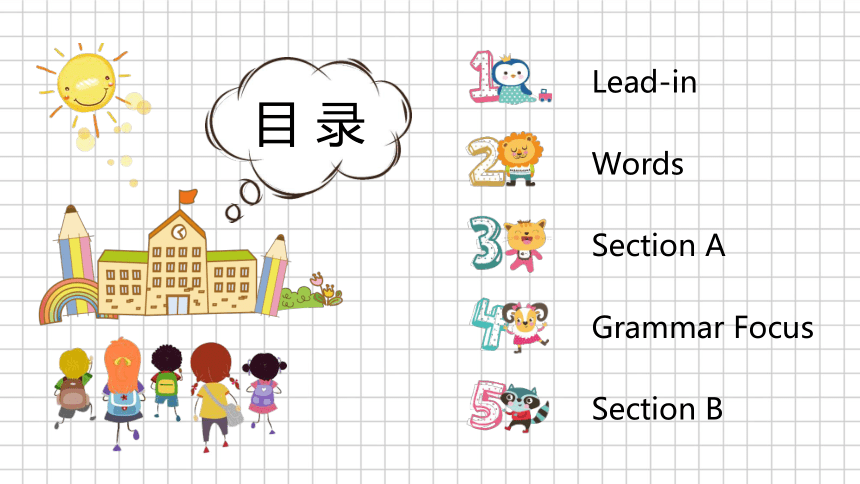



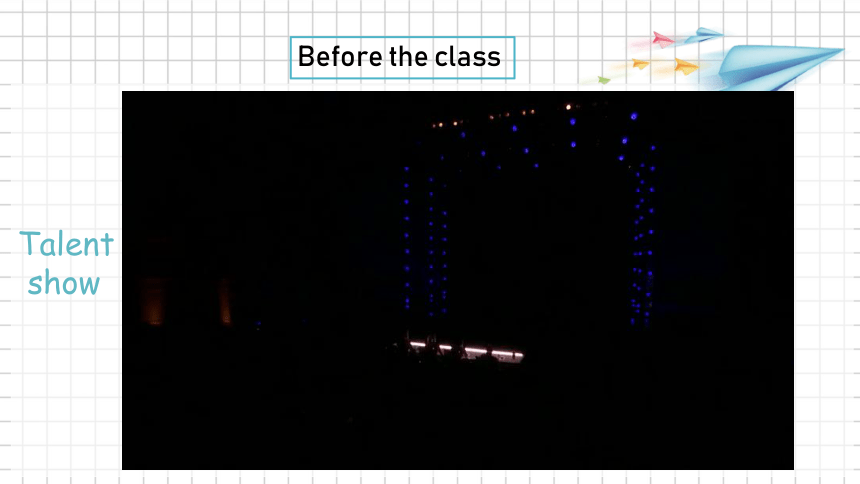
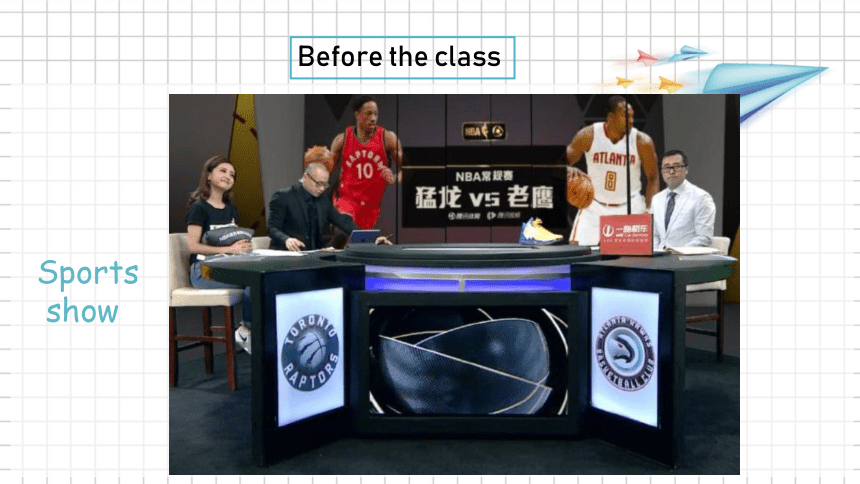
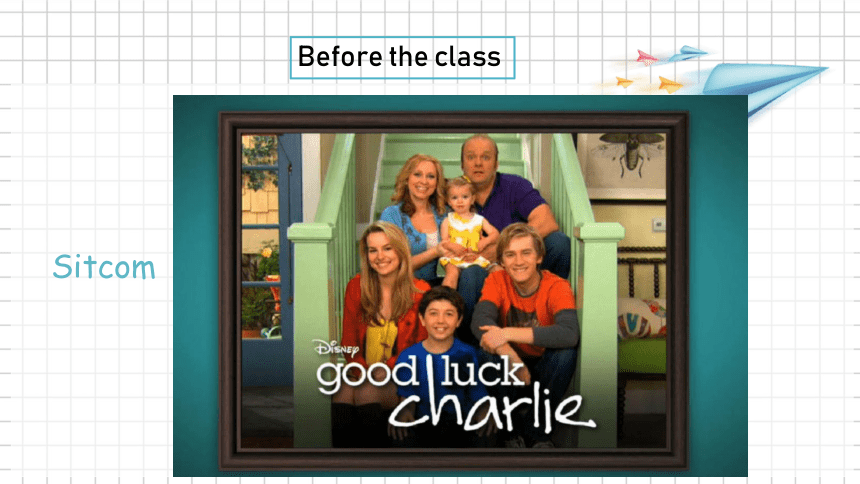
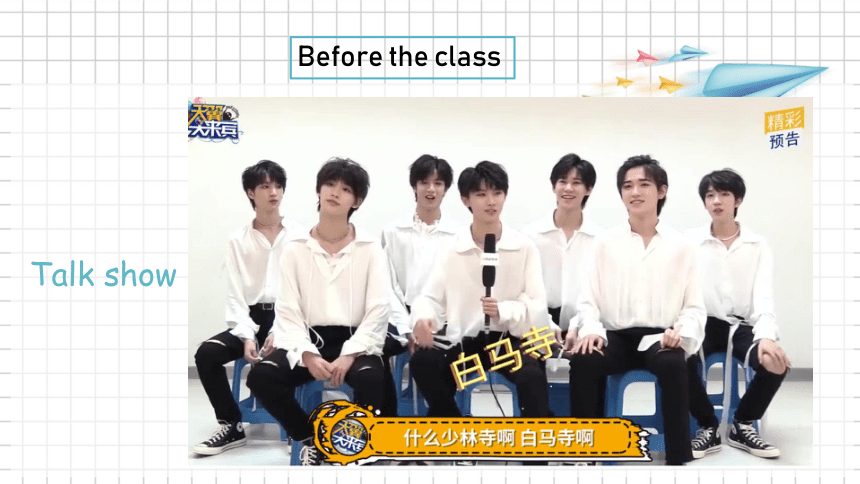


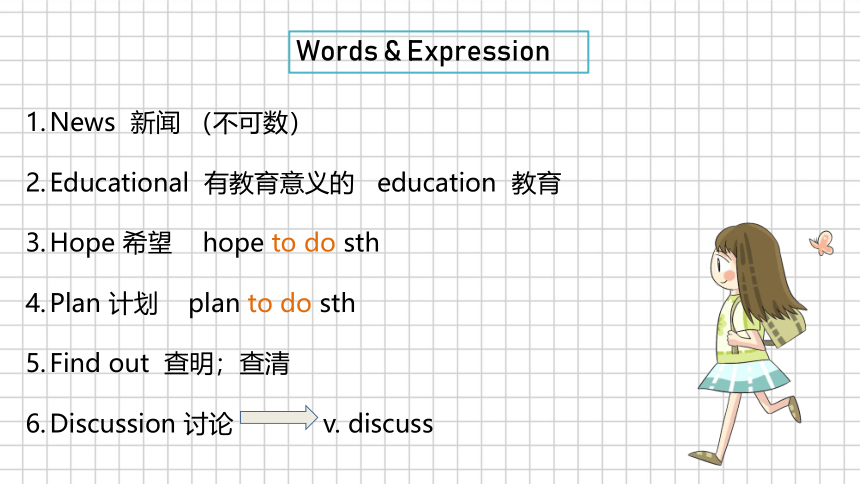
文档简介
(共42张PPT)
Unit5
Do
you
want
to
watch
a
game
show?
Lead-in
Words
Section
A
Grammar
Focus
Section
B
目
录
Lead-in
Before
the
class
Write
down
the
types
of
TV
shows
and
practice
the
conversation.
A:
What
do
you
want
to
watch?
B:
What
do
you
think
of
talk
shows?
A:
They’re
OK.
I
don’t
mind
them.
B:
Then
let’s
watch
a
talk
show.
talent
show
news
sports
show
talk
show
soap
opera
game
show
cartoon
situation
comedy
(sitcom)
Before
the
class
News
Before
the
class
Talent
show
Before
the
class
Sports
show
Before
the
class
Sitcom
Before
the
class
Talk
show
Before
the
class
Cartoon
Words
Words
&
Expression
News
新闻
(不可数)
Educational
有教育意义的
education
教育
Hope
希望
hope
to
do
sth
Plan
计划
plan
to
do
sth
Find
out
查明;查清
Discussion
讨论
v.
discuss
Words
&
Expression
7.
Stand
忍受;站立
stood
8.
Happen
发生;碰巧
9.
May
也许;可能;可以
May
I
come
in?
10.
Expect
期待
expect
to
do
sth
11.
Joke
笑话;玩笑
12.
Meaningless
毫无意义的
meaningful
有意义的
Words
&
Expression
13.
Action
动作
14.
Cartoon
卡通
15.
Action
movie
动作电影
16.
Culture
文化;文明
17.
Famous
著名的
be
famous
for
/be
famous
as
18.
Appear
出现
appearance
外貌,外观
Words
&
Expression
19.
Become
成为,变成
became
20.
Rich
富有的;丰富的
21.
Successful
成功的
n.
Success
v.
succeed
22.
Might
可能,可以
+do
23.
Main
最主要的
24.
Reason
原因
Words
&
Expression
25.
Common
常见的,普通的
26.
Film
电影
see
a
film/movie
看电影
27.
Unlucky
不幸的
unluckily
不幸地
lucky
幸运的
28.
Lose
失去,丢失
29.
Be/get
ready
to
愿意迅速做某事
30.
Character
人物,角色
Words
&
Expression
31.
Simple
简单的,易做的
32.
Dress
up
乔装打扮
33.
Take
sb’s
place
取代某人
34.
Army
陆军
35.
Do
a
good
job
干得好
Section
A
Role-play
the
Conversation
Grace:
What
did
you
do
in
class
today,
Sarah?
Sarah:
We
had
a
discussion
about
TV
shows.
My
classmates
like
game
shows
and
sports
shows.
Grace:
Oh,
I
can’t
stand
them.
But
I
love
soap
operas.
I
like
to
follow
the
story
and
see
what
happens
next.
Sarah:
Well,
I
don’t
mind
soap
operas.
But
my
favorite
show
is
news.
Because
I
like
to
find
out
what
is
going
on
around
the
world.
Grace:
It’s
boring.
Sarah:
Well,
it
may
not
be
very
exciting,
but
you
can
expect
to
learn
a
lot
from
it,
I
hope
to
be
a
reporter
one
day.
关于
表明态度:我无法忍受它们
跟随,跟着
表面态度:我不介意肥皂剧
查明,查清
全世界
期待去做某事
Learn
sth
from…从…学到…
将来的某一天
Grammar
Focus
Grammar
Focus
Do
you
want
to
watch
the
news?
Yes,
I
do.
/
No,
I
don't.
What
do
you
plan
to
watch
tonight?
I
plan
to
watch
Days
of
Our
Past.
What
can
you
expect
to
learn
from
Sitcom?
I
can
learn
some
great
jokes.
Why
do
you
like
watching
the
news?
Because
I
hope
to
find
out
what's
going
on
around
the
world.
What
do
you
think
of
talk
shows?
I
don't
mind
them.
/
I
can't
stand
them.
/
I
love
watching
them.
=How
do
you
like…
你觉得…怎么样
表明态度的几种说法
Grammar
Focus
1.
Hope
to
do
sth?
希望去做某事
2.
Agree
to
do
sth?
同意去做某事
3.
Promise
to
do
sth
承诺去做某事
4.
Refuse
to
do
sth?
拒绝去做某事
5.
Learn
to
do
sth?
学着去做某事
6.
Decide
to
do
sth?
决定去做某事
7.
Choose
to
do
sth?
选择去做某事
8.
Offer
to
do
sth?
主动提出去做某事
9.
Plan
to
do
sth?
计划去做某事
10.
Prepare
to
do
sth?
准备去做某事
Grammar
Focus
11.
Happen
to
do
sth?
碰巧去做某事
12.
Would
like
to
do
sth?
想要去做某事
13.
Can’t
wait
to
do
sth?
迫不及待去做某事
14.
Want
sb
to
do
sth
想要某人去做某事
15.
Tell
sb
to
do
sth?
告诉某人去做某事
16.
Advise
sb
to
do
sth?
建议某人去做某事
17.
Encourage
sb
to
do
sth?
鼓励某人去做某事
18.
Allow
sb
to
do
sth?
允许某人去做某事
19.
Invite
sb
to
do
sth?
邀请某人去做某事
20.
Remind
sb
to
do
sth?
提醒某人去做某事
Grammar
Focus
21.
Teach
sb
to
do
sth?
教某人去做某事
22.
Wish
sb
to
do
sth?
希望某人去做某事
23.
Expect
sb
to
do
sth?
期待某人去做某事
24.
Ask
sb
to
do
sth?
要求某人去做
某事
二、表示目的的时候用to
do
Eg:
I
come
here
to
learn
something.
我来这里(目的是)学东西
Grammar
Focus
三、含有to
do的常见句型
1.
too
+adj.
/adv+
to
do
sth
太…而不能…
2.
(not)
adj./adv.
+
enough
+to
do
sth
(不)足够…去做某事…
Eg.
:
He
is
not
old
enough
to
go
to
school.
3.
It
is
+
adj./adv.
(for
sb)
to
do
sth
做某事对于某人来说,是…样的
4.
It
is
+
adj./adv.
(of
sb)
to
do
sth
做了某事,某人是…样的,
5.
Sb
find/think/feel
it
+
adj.
+to
do
sth
某人
发现/认为/感觉
做某事是…样的
6.
It’s
time
for
sb
to
do
sth
到某人做某事的时间了
7.
It
takes
sb
时间/钱
to
do
sth
花了某人时间/钱去做某事
Grammar
Focus
四、动词不定式
to
do
一般作后置定语,放在名词或代词之后。
I
have
a
lot
of
homework
to
do.
(to
do
作homework的后置定语,同时这里to
do
还表将来)
2.
I
want
something
to
eat.
(to
eat
作something的后置定语,同时这里to
do
还表将来)
五、结构:疑问词+
to
do
,可在句中作主语,宾语,表语等。
Where
to
stay
is
not
been
decided.
(疑问词+
to
do
在句中作主语)
I
don't
know
how
to
get
to
the
Scholar.
(疑问词+
to
do
在句中作宾语)
The
question
is
how
to
make
her
happy.
(疑问词+
to
do
在句中作表语)
Section
B
关键
文本
Section
B
2b
What
do
you
know
about
Disneyland?
关键
文本
Who’s
got
talent?
2b
6mins
圈出不会的单词并完成
阅读题目~
When
people
say
“culture”,
we
think
of
art
and
history.
But
one
very
famous
symbol
in
American
culture
is
a
cartoon.
We
all
know
and
love
the
black
mouse
with
two
large
round
ears
—
Mickey
Mouse.
Over
80
years
ago,
he
first
appeared
in
the
cartoon
Steamboat
Willie.
When
this
cartoon
came
out
in
New
York
on
November
18,
1928,
it
was
the
first
cartoon
with
sound
and
music.
The
man
behind
Mickey
was
Walt
Disney.
He
became
very
rich
and
successful.
In
the
1930s,
he
made
87
cartoons
with
Mickey.
Some
people
might
ask
how
this
cartoon
animal
became
so
popular.
One
of
the
main
reasons
is
that
Mickey
was
like
a
common
man,
but
he
always
tried
to
face
any
danger.
In
his
early
films,
Mickey
was
unlucky
and
had
many
problems
such
as
losing
his
house
or
girlfriend,
Minnie.
However,
he
was
always
ready
to
try
his
best.
People
went
to
the
cinema
to
see
the
“little
man”
win.
Most
of
them
wanted
to
be
like
Mickey.
On
November
18,
1978,
Mickey
became
the
first
cartoon
character
to
have
a
star
on
the
Hollywood
Walk
of
Fame.
Today’s
cartoons
are
usually
not
so
simple
as
little
Mickey
Mouse,
but
everyone
still
knows
and
loves
him.
Who
has
a
pair
of
ears
more
famous
than
Mickey’s?
关键
文本
2b
Task
1
Read
the
passage
and
match
the
main
idea
of
each
paragraph.
Paragraph
1
Paragraph
2
Paragraph
3
?
Mickey
Mouse
is
still
popular.
Cartoon
is
one
of
the
symbols
of
American
culture.
Why
Mickey
Mouse
became
so
popular.
Task
2
Fill
in
the
chart
according
to
the
time.
1930s
November
18,
1978
___________
____________
____________
____________
?
Steamboat
Willie
came
out
in
New
York.
November
18,1928
Walt
Disney
made
87
cartoons
with
Mickey.
______________________
______________________
______________________
?
Mickey
became
the
first
cartoon
character
to
have
a
star
on
the
Hollywood
Walk
of
Fame.
关键
文本
2b
Careful-reading
Task
1
Are
they
true
(T)
or
false
(F)?
(
)
1.
Mickey
is
a
mouse
with
two
large
long
ears.
(
)
2.
Walt
Disney
was
a
smart
and
successful
man.
(
)
3.
Mickey
was
not
afraid
to
face
any
danger.
(
)
4.
People
wanted
to
be
like
Mickey
because
he
was
a
little
man.
(
)
5.
No
cartoon
characters
had
a
star
on
the
Hollywood
Walk
of
Fame
before
Mickey.
Task
2
Fill
in
the
information
chart
of
Mickey.
F
F
T
F
T
He
is
a
black
mouse
with
two
large
round
ears.
Walt
Disney
Steamboat
Willie
Minne
He
always
tried
to
face
any
danger.
关键
文本
2b
When
people
say
“culture”,
we
think
of
art
and
history.
But
one
very
famous
symbol
in
American
culture
is
a
cartoon.
We
all
know
and
love
the
black
mouse
with
two
large
round
ears
—
Mickey
Mouse.
Over
80
years
ago,
he
first
appeared
in
the
cartoon
Steamboat
Willie.
When
this
cartoon
came
out
in
New
York
on
November
18,
1928,
it
was
the
first
cartoon
with
sound
and
music.
The
man
behind
Mickey
was
Walt
Disney.
He
became
very
rich
and
successful.
In
the
1930s,
he
made
87
cartoons
with
Mickey.
careful-reading
Take
notes~
文化
想起;考虑到
著名的
卡通片
带有…
V.
出现
出来,出版
adj.
成功的
在20世纪30年代
关键
文本
2b
careful-reading
Take
notes~
Some
people
might
ask
how
this
cartoon
animal
became
so
popular.
One
of
the
main
reasons
is
that
Mickey
was
like
a
common
man,
but
he
always
tried
to
face
any
danger.
In
his
early
films,
Mickey
was
unlucky
and
had
many
problems
such
as
losing
his
house
or
girlfriend,
Minnie.
However,
he
was
always
ready
to
try
his
best.
People
went
to
the
cinema
to
see
the
“little
man”
win.
Most
of
them
wanted
to
be
like
Mickey.
On
November
18,
1978,
Mickey
became
the
first
cartoon
character
to
have
a
star
on
the
Hollywood
Walk
of
Fame.
Today’s
cartoons
are
usually
not
so
simple
as
little
Mickey
Mouse,
but
everyone
still
knows
and
loves
him.
Who
has
a
pair
of
ears
more
famous
than
Mickey’s?
主要要原因之一
努力去做某事
面对任何危险
adj.
不幸的
例如
be
ready
to
do
sth.
准备做某事
大多数
像…一样
n.
人物;个性
not
so…as…
不如…
关键
文本
2b
Language
points
Sentences
句型1
But
one
very
famous
symbol
in
American
culture
is
a
cartoon.
famous的拓展运用:
①
be
famous
for:
(以…出名)
②
be
famous
as:
(作为…而出名)
【学以致用】
1.
Li
Bai
is
famous
_______
his
poetry
and
he
is
famous
_______
poet.
2.
China
is
very
famous
_______
the
Great
Wall
and
pandas.
3.
J.K.
Rowling
is
famous
_______
Harry
Potter.
for
as
for
for
关键
文本
2b
Language
points
句型2
We
all
know
and
love
the
black
mouse
with
two
large
round
ears
—
Mickey
Mouse.
with的三种用法:①
表“带有、有…的”
②
表“和、同、与”
③
表“用、以、被”
【学以致用】以下的例句中with是什么用法?
1.
Doraemon
is
a
robot
cat
with
a
magic
pocket.
_______
2.
I
bought
a
house
with
a
large
garden.
_______
3.
The
girl
with
long
hair
is
my
classmate.
_______
4.
Can
you
go
to
the
park
with
me?
_______
5.
Don’t
write
with
red
pen.
_______
6.
The
school
with
a
large
playground
is
my
school.
_______
①
②
③
①
①
①
关键
文本
2b
Language
points
句型3
He
always
tried
to
face
any
danger.
danger
词汇拓展:
①
danger
__________
词性
_________
②
dangerous
__________
词性
_________
③
endangered
__________
词性
_________
be
in
danger
__________
out
of
danger
____________
【学以致用】
1.
She
volunteered
for
a
__________
mission.
2.
These
are
home
to
many
__________
birds
and
fish.
3.
What
traditions
in
China
are
disappearing
or
are
in
______
of
disappearing?
危险
n.
危险的
adj.
濒临灭绝的
adj.
处于危险中
脱离危险
dangerous
endangered
danger
关键
文本
2b
Language
points
句型4
However,
he
was
always
ready
to
try
his
best.
try的用法:
①
try
doing
尝试做某事
②
try
to
do
努力做某事
③
try
one’s
best
尽力做某事
【学以致用】
1.
When
you
go
across
the
road,
you
must
_____________
(be)
more
careful
2.
Lately,
I’m
interested
in
gardening.
And
I
_______________
(garden),
but
I
failed.
3.
_______________,
or
you
will
regret!
try
to
be
try
gardening
Try
your
best
关键
文本
2b
Language
points
句型5
Today’s
cartoons
are
usually
not
so
simple
as
little
Mickey
Mouse.
not
so….as:不像….
【学以致用】翻译
1.
人们不再像以前那样诚实了。
_____________________________________________________________
2.
事实不像他期望的那么简单。
_____________________________________________________________
People
are
not
so
honest
as
they
once
were.
The
fact
is
not
so
easy
as
he
expected.
关键
文本
Further-reading
关键
文本
In
1933
an
unknown
American
called
Clarence
Nash
went
to
see
the
film-maker
Walt
Disney.
He
had
an
unusual
voice
and
he
wanted
to
work
in
Disney’s
cartoon
films
for
children.
When
Walt
Disney
heard
Nash’s
voice,
he
said,
“Stop!
That’s
our
duck!”
The
duck
was
the
now-famous
Donald
Duck,
who
first
appeared
in
1934
in
the
film,
The
Wise
Little
Hen.
Donald
lived
in
an
old
houseboat
and
wore
his
sailor
jacket
and
hat.
Later
that
year
he
became
a
star
after
an
eight-minute
Mickey
Mouse
film.
The
cinema
audience(观众)liked
him
because
he
was
lazy
and
greedy,
and
because
he
lost
his
temper
very
easily.
And
they
loved
his
voice
when
he
became
angry
with
Mickey’s
eight
nephews.
Soon
Donald
was
more
popular
than
Mickey
Mouse
himself,
probably
because
he
wasn’t
a
goody-goody,
like
Mickey.
In
the
1930s,
the
1940s,
and
the
1950s,
Donald
and
his
friends
Mickey,
Goofy
and
Pluto
made
hundreds
of
Disney
cartoons.
He
also
made
educational
films
about
the
place
of
the
USA
in
the
world,
and
safety
in
the
home.
Then
in
1966
Donald
Duck
and
his
voice
disappeared
—
there
were
no
more
new
cartoons.
Clarence
Nash
died
in
February,
1985.
But
today’s
children
can
still
see
the
old
cartoons
on
television
and
hear
that
famous
voice.
Further-reading
关键
文本
(
)
1.
Who
was
a
film-maker?
A.
Mickey
Mouse.
B.
Clarence
Nash.
C.
Walt
Disney.
D.
Pluto.
(
)
2.
When
did
Donald
Duck
first
appear?
A.
In
1933.
B.
In
1934.
C.
In
1966.
D.
In
1965.
(
)
3.
Who
was
Clarence
Nash?
A.
A
cartoonist.
B.
A
writer.
C.
A
film-maker.
D.
The
man
who
made
the
voice
for
Donald
Duck.
(
)
4.
Where
can
today’s
children
see
Donald
Duck?
A.
In
new
cartoons.
B.
At
the
cinema
C.
On
television.
D.
In
the
theater.
(
)
5.
Why
did
people
like
Donald
better
than
Mickey
Mouse?
A.
Probably
because
he
was
lazy
and
greedy.
B.
Probably
because
he
wasn’t
a
goody-goody
like
Mickey.
C.
Probably
because
he
lost
his
temper
very
easily.
D.
Probably
because
he
became
angry
with
Mickey’s
eight
nephews.
C
B
D
C
B
Further-reading
Thank
You
Unit5
Do
you
want
to
watch
a
game
show?
Lead-in
Words
Section
A
Grammar
Focus
Section
B
目
录
Lead-in
Before
the
class
Write
down
the
types
of
TV
shows
and
practice
the
conversation.
A:
What
do
you
want
to
watch?
B:
What
do
you
think
of
talk
shows?
A:
They’re
OK.
I
don’t
mind
them.
B:
Then
let’s
watch
a
talk
show.
talent
show
news
sports
show
talk
show
soap
opera
game
show
cartoon
situation
comedy
(sitcom)
Before
the
class
News
Before
the
class
Talent
show
Before
the
class
Sports
show
Before
the
class
Sitcom
Before
the
class
Talk
show
Before
the
class
Cartoon
Words
Words
&
Expression
News
新闻
(不可数)
Educational
有教育意义的
education
教育
Hope
希望
hope
to
do
sth
Plan
计划
plan
to
do
sth
Find
out
查明;查清
Discussion
讨论
v.
discuss
Words
&
Expression
7.
Stand
忍受;站立
stood
8.
Happen
发生;碰巧
9.
May
也许;可能;可以
May
I
come
in?
10.
Expect
期待
expect
to
do
sth
11.
Joke
笑话;玩笑
12.
Meaningless
毫无意义的
meaningful
有意义的
Words
&
Expression
13.
Action
动作
14.
Cartoon
卡通
15.
Action
movie
动作电影
16.
Culture
文化;文明
17.
Famous
著名的
be
famous
for
/be
famous
as
18.
Appear
出现
appearance
外貌,外观
Words
&
Expression
19.
Become
成为,变成
became
20.
Rich
富有的;丰富的
21.
Successful
成功的
n.
Success
v.
succeed
22.
Might
可能,可以
+do
23.
Main
最主要的
24.
Reason
原因
Words
&
Expression
25.
Common
常见的,普通的
26.
Film
电影
see
a
film/movie
看电影
27.
Unlucky
不幸的
unluckily
不幸地
lucky
幸运的
28.
Lose
失去,丢失
29.
Be/get
ready
to
愿意迅速做某事
30.
Character
人物,角色
Words
&
Expression
31.
Simple
简单的,易做的
32.
Dress
up
乔装打扮
33.
Take
sb’s
place
取代某人
34.
Army
陆军
35.
Do
a
good
job
干得好
Section
A
Role-play
the
Conversation
Grace:
What
did
you
do
in
class
today,
Sarah?
Sarah:
We
had
a
discussion
about
TV
shows.
My
classmates
like
game
shows
and
sports
shows.
Grace:
Oh,
I
can’t
stand
them.
But
I
love
soap
operas.
I
like
to
follow
the
story
and
see
what
happens
next.
Sarah:
Well,
I
don’t
mind
soap
operas.
But
my
favorite
show
is
news.
Because
I
like
to
find
out
what
is
going
on
around
the
world.
Grace:
It’s
boring.
Sarah:
Well,
it
may
not
be
very
exciting,
but
you
can
expect
to
learn
a
lot
from
it,
I
hope
to
be
a
reporter
one
day.
关于
表明态度:我无法忍受它们
跟随,跟着
表面态度:我不介意肥皂剧
查明,查清
全世界
期待去做某事
Learn
sth
from…从…学到…
将来的某一天
Grammar
Focus
Grammar
Focus
Do
you
want
to
watch
the
news?
Yes,
I
do.
/
No,
I
don't.
What
do
you
plan
to
watch
tonight?
I
plan
to
watch
Days
of
Our
Past.
What
can
you
expect
to
learn
from
Sitcom?
I
can
learn
some
great
jokes.
Why
do
you
like
watching
the
news?
Because
I
hope
to
find
out
what's
going
on
around
the
world.
What
do
you
think
of
talk
shows?
I
don't
mind
them.
/
I
can't
stand
them.
/
I
love
watching
them.
=How
do
you
like…
你觉得…怎么样
表明态度的几种说法
Grammar
Focus
1.
Hope
to
do
sth?
希望去做某事
2.
Agree
to
do
sth?
同意去做某事
3.
Promise
to
do
sth
承诺去做某事
4.
Refuse
to
do
sth?
拒绝去做某事
5.
Learn
to
do
sth?
学着去做某事
6.
Decide
to
do
sth?
决定去做某事
7.
Choose
to
do
sth?
选择去做某事
8.
Offer
to
do
sth?
主动提出去做某事
9.
Plan
to
do
sth?
计划去做某事
10.
Prepare
to
do
sth?
准备去做某事
Grammar
Focus
11.
Happen
to
do
sth?
碰巧去做某事
12.
Would
like
to
do
sth?
想要去做某事
13.
Can’t
wait
to
do
sth?
迫不及待去做某事
14.
Want
sb
to
do
sth
想要某人去做某事
15.
Tell
sb
to
do
sth?
告诉某人去做某事
16.
Advise
sb
to
do
sth?
建议某人去做某事
17.
Encourage
sb
to
do
sth?
鼓励某人去做某事
18.
Allow
sb
to
do
sth?
允许某人去做某事
19.
Invite
sb
to
do
sth?
邀请某人去做某事
20.
Remind
sb
to
do
sth?
提醒某人去做某事
Grammar
Focus
21.
Teach
sb
to
do
sth?
教某人去做某事
22.
Wish
sb
to
do
sth?
希望某人去做某事
23.
Expect
sb
to
do
sth?
期待某人去做某事
24.
Ask
sb
to
do
sth?
要求某人去做
某事
二、表示目的的时候用to
do
Eg:
I
come
here
to
learn
something.
我来这里(目的是)学东西
Grammar
Focus
三、含有to
do的常见句型
1.
too
+adj.
/adv+
to
do
sth
太…而不能…
2.
(not)
adj./adv.
+
enough
+to
do
sth
(不)足够…去做某事…
Eg.
:
He
is
not
old
enough
to
go
to
school.
3.
It
is
+
adj./adv.
(for
sb)
to
do
sth
做某事对于某人来说,是…样的
4.
It
is
+
adj./adv.
(of
sb)
to
do
sth
做了某事,某人是…样的,
5.
Sb
find/think/feel
it
+
adj.
+to
do
sth
某人
发现/认为/感觉
做某事是…样的
6.
It’s
time
for
sb
to
do
sth
到某人做某事的时间了
7.
It
takes
sb
时间/钱
to
do
sth
花了某人时间/钱去做某事
Grammar
Focus
四、动词不定式
to
do
一般作后置定语,放在名词或代词之后。
I
have
a
lot
of
homework
to
do.
(to
do
作homework的后置定语,同时这里to
do
还表将来)
2.
I
want
something
to
eat.
(to
eat
作something的后置定语,同时这里to
do
还表将来)
五、结构:疑问词+
to
do
,可在句中作主语,宾语,表语等。
Where
to
stay
is
not
been
decided.
(疑问词+
to
do
在句中作主语)
I
don't
know
how
to
get
to
the
Scholar.
(疑问词+
to
do
在句中作宾语)
The
question
is
how
to
make
her
happy.
(疑问词+
to
do
在句中作表语)
Section
B
关键
文本
Section
B
2b
What
do
you
know
about
Disneyland?
关键
文本
Who’s
got
talent?
2b
6mins
圈出不会的单词并完成
阅读题目~
When
people
say
“culture”,
we
think
of
art
and
history.
But
one
very
famous
symbol
in
American
culture
is
a
cartoon.
We
all
know
and
love
the
black
mouse
with
two
large
round
ears
—
Mickey
Mouse.
Over
80
years
ago,
he
first
appeared
in
the
cartoon
Steamboat
Willie.
When
this
cartoon
came
out
in
New
York
on
November
18,
1928,
it
was
the
first
cartoon
with
sound
and
music.
The
man
behind
Mickey
was
Walt
Disney.
He
became
very
rich
and
successful.
In
the
1930s,
he
made
87
cartoons
with
Mickey.
Some
people
might
ask
how
this
cartoon
animal
became
so
popular.
One
of
the
main
reasons
is
that
Mickey
was
like
a
common
man,
but
he
always
tried
to
face
any
danger.
In
his
early
films,
Mickey
was
unlucky
and
had
many
problems
such
as
losing
his
house
or
girlfriend,
Minnie.
However,
he
was
always
ready
to
try
his
best.
People
went
to
the
cinema
to
see
the
“little
man”
win.
Most
of
them
wanted
to
be
like
Mickey.
On
November
18,
1978,
Mickey
became
the
first
cartoon
character
to
have
a
star
on
the
Hollywood
Walk
of
Fame.
Today’s
cartoons
are
usually
not
so
simple
as
little
Mickey
Mouse,
but
everyone
still
knows
and
loves
him.
Who
has
a
pair
of
ears
more
famous
than
Mickey’s?
关键
文本
2b
Task
1
Read
the
passage
and
match
the
main
idea
of
each
paragraph.
Paragraph
1
Paragraph
2
Paragraph
3
?
Mickey
Mouse
is
still
popular.
Cartoon
is
one
of
the
symbols
of
American
culture.
Why
Mickey
Mouse
became
so
popular.
Task
2
Fill
in
the
chart
according
to
the
time.
1930s
November
18,
1978
___________
____________
____________
____________
?
Steamboat
Willie
came
out
in
New
York.
November
18,1928
Walt
Disney
made
87
cartoons
with
Mickey.
______________________
______________________
______________________
?
Mickey
became
the
first
cartoon
character
to
have
a
star
on
the
Hollywood
Walk
of
Fame.
关键
文本
2b
Careful-reading
Task
1
Are
they
true
(T)
or
false
(F)?
(
)
1.
Mickey
is
a
mouse
with
two
large
long
ears.
(
)
2.
Walt
Disney
was
a
smart
and
successful
man.
(
)
3.
Mickey
was
not
afraid
to
face
any
danger.
(
)
4.
People
wanted
to
be
like
Mickey
because
he
was
a
little
man.
(
)
5.
No
cartoon
characters
had
a
star
on
the
Hollywood
Walk
of
Fame
before
Mickey.
Task
2
Fill
in
the
information
chart
of
Mickey.
F
F
T
F
T
He
is
a
black
mouse
with
two
large
round
ears.
Walt
Disney
Steamboat
Willie
Minne
He
always
tried
to
face
any
danger.
关键
文本
2b
When
people
say
“culture”,
we
think
of
art
and
history.
But
one
very
famous
symbol
in
American
culture
is
a
cartoon.
We
all
know
and
love
the
black
mouse
with
two
large
round
ears
—
Mickey
Mouse.
Over
80
years
ago,
he
first
appeared
in
the
cartoon
Steamboat
Willie.
When
this
cartoon
came
out
in
New
York
on
November
18,
1928,
it
was
the
first
cartoon
with
sound
and
music.
The
man
behind
Mickey
was
Walt
Disney.
He
became
very
rich
and
successful.
In
the
1930s,
he
made
87
cartoons
with
Mickey.
careful-reading
Take
notes~
文化
想起;考虑到
著名的
卡通片
带有…
V.
出现
出来,出版
adj.
成功的
在20世纪30年代
关键
文本
2b
careful-reading
Take
notes~
Some
people
might
ask
how
this
cartoon
animal
became
so
popular.
One
of
the
main
reasons
is
that
Mickey
was
like
a
common
man,
but
he
always
tried
to
face
any
danger.
In
his
early
films,
Mickey
was
unlucky
and
had
many
problems
such
as
losing
his
house
or
girlfriend,
Minnie.
However,
he
was
always
ready
to
try
his
best.
People
went
to
the
cinema
to
see
the
“little
man”
win.
Most
of
them
wanted
to
be
like
Mickey.
On
November
18,
1978,
Mickey
became
the
first
cartoon
character
to
have
a
star
on
the
Hollywood
Walk
of
Fame.
Today’s
cartoons
are
usually
not
so
simple
as
little
Mickey
Mouse,
but
everyone
still
knows
and
loves
him.
Who
has
a
pair
of
ears
more
famous
than
Mickey’s?
主要要原因之一
努力去做某事
面对任何危险
adj.
不幸的
例如
be
ready
to
do
sth.
准备做某事
大多数
像…一样
n.
人物;个性
not
so…as…
不如…
关键
文本
2b
Language
points
Sentences
句型1
But
one
very
famous
symbol
in
American
culture
is
a
cartoon.
famous的拓展运用:
①
be
famous
for:
(以…出名)
②
be
famous
as:
(作为…而出名)
【学以致用】
1.
Li
Bai
is
famous
_______
his
poetry
and
he
is
famous
_______
poet.
2.
China
is
very
famous
_______
the
Great
Wall
and
pandas.
3.
J.K.
Rowling
is
famous
_______
Harry
Potter.
for
as
for
for
关键
文本
2b
Language
points
句型2
We
all
know
and
love
the
black
mouse
with
two
large
round
ears
—
Mickey
Mouse.
with的三种用法:①
表“带有、有…的”
②
表“和、同、与”
③
表“用、以、被”
【学以致用】以下的例句中with是什么用法?
1.
Doraemon
is
a
robot
cat
with
a
magic
pocket.
_______
2.
I
bought
a
house
with
a
large
garden.
_______
3.
The
girl
with
long
hair
is
my
classmate.
_______
4.
Can
you
go
to
the
park
with
me?
_______
5.
Don’t
write
with
red
pen.
_______
6.
The
school
with
a
large
playground
is
my
school.
_______
①
②
③
①
①
①
关键
文本
2b
Language
points
句型3
He
always
tried
to
face
any
danger.
danger
词汇拓展:
①
danger
__________
词性
_________
②
dangerous
__________
词性
_________
③
endangered
__________
词性
_________
be
in
danger
__________
out
of
danger
____________
【学以致用】
1.
She
volunteered
for
a
__________
mission.
2.
These
are
home
to
many
__________
birds
and
fish.
3.
What
traditions
in
China
are
disappearing
or
are
in
______
of
disappearing?
危险
n.
危险的
adj.
濒临灭绝的
adj.
处于危险中
脱离危险
dangerous
endangered
danger
关键
文本
2b
Language
points
句型4
However,
he
was
always
ready
to
try
his
best.
try的用法:
①
try
doing
尝试做某事
②
try
to
do
努力做某事
③
try
one’s
best
尽力做某事
【学以致用】
1.
When
you
go
across
the
road,
you
must
_____________
(be)
more
careful
2.
Lately,
I’m
interested
in
gardening.
And
I
_______________
(garden),
but
I
failed.
3.
_______________,
or
you
will
regret!
try
to
be
try
gardening
Try
your
best
关键
文本
2b
Language
points
句型5
Today’s
cartoons
are
usually
not
so
simple
as
little
Mickey
Mouse.
not
so….as:不像….
【学以致用】翻译
1.
人们不再像以前那样诚实了。
_____________________________________________________________
2.
事实不像他期望的那么简单。
_____________________________________________________________
People
are
not
so
honest
as
they
once
were.
The
fact
is
not
so
easy
as
he
expected.
关键
文本
Further-reading
关键
文本
In
1933
an
unknown
American
called
Clarence
Nash
went
to
see
the
film-maker
Walt
Disney.
He
had
an
unusual
voice
and
he
wanted
to
work
in
Disney’s
cartoon
films
for
children.
When
Walt
Disney
heard
Nash’s
voice,
he
said,
“Stop!
That’s
our
duck!”
The
duck
was
the
now-famous
Donald
Duck,
who
first
appeared
in
1934
in
the
film,
The
Wise
Little
Hen.
Donald
lived
in
an
old
houseboat
and
wore
his
sailor
jacket
and
hat.
Later
that
year
he
became
a
star
after
an
eight-minute
Mickey
Mouse
film.
The
cinema
audience(观众)liked
him
because
he
was
lazy
and
greedy,
and
because
he
lost
his
temper
very
easily.
And
they
loved
his
voice
when
he
became
angry
with
Mickey’s
eight
nephews.
Soon
Donald
was
more
popular
than
Mickey
Mouse
himself,
probably
because
he
wasn’t
a
goody-goody,
like
Mickey.
In
the
1930s,
the
1940s,
and
the
1950s,
Donald
and
his
friends
Mickey,
Goofy
and
Pluto
made
hundreds
of
Disney
cartoons.
He
also
made
educational
films
about
the
place
of
the
USA
in
the
world,
and
safety
in
the
home.
Then
in
1966
Donald
Duck
and
his
voice
disappeared
—
there
were
no
more
new
cartoons.
Clarence
Nash
died
in
February,
1985.
But
today’s
children
can
still
see
the
old
cartoons
on
television
and
hear
that
famous
voice.
Further-reading
关键
文本
(
)
1.
Who
was
a
film-maker?
A.
Mickey
Mouse.
B.
Clarence
Nash.
C.
Walt
Disney.
D.
Pluto.
(
)
2.
When
did
Donald
Duck
first
appear?
A.
In
1933.
B.
In
1934.
C.
In
1966.
D.
In
1965.
(
)
3.
Who
was
Clarence
Nash?
A.
A
cartoonist.
B.
A
writer.
C.
A
film-maker.
D.
The
man
who
made
the
voice
for
Donald
Duck.
(
)
4.
Where
can
today’s
children
see
Donald
Duck?
A.
In
new
cartoons.
B.
At
the
cinema
C.
On
television.
D.
In
the
theater.
(
)
5.
Why
did
people
like
Donald
better
than
Mickey
Mouse?
A.
Probably
because
he
was
lazy
and
greedy.
B.
Probably
because
he
wasn’t
a
goody-goody
like
Mickey.
C.
Probably
because
he
lost
his
temper
very
easily.
D.
Probably
because
he
became
angry
with
Mickey’s
eight
nephews.
C
B
D
C
B
Further-reading
Thank
You
同课章节目录
- Unit 1 Where did you go on vacation?
- Section A
- Section B
- Unit 2 How often do you exercise?
- Section A
- Section B
- Unit 3 I'm more outgoing than my sister.
- Section A
- Section B
- Unit 4 What's the best movie theater?
- Section A
- Section B
- Unit 5 Do you want to watch a game show?
- Section A
- Section B
- Unit 6 I'm going to study computer science.
- Section A
- Section B
- Unit 7 Will people have robots?
- Section A
- Section B
- Unit 8 How do you make a banana milk shake?
- Section A
- Section B
- Unit 9 Can you come to my party?
- Section A
- Section B
- Unit 10 If you go to the party, you'll have a grea
- Section A
- Section B
